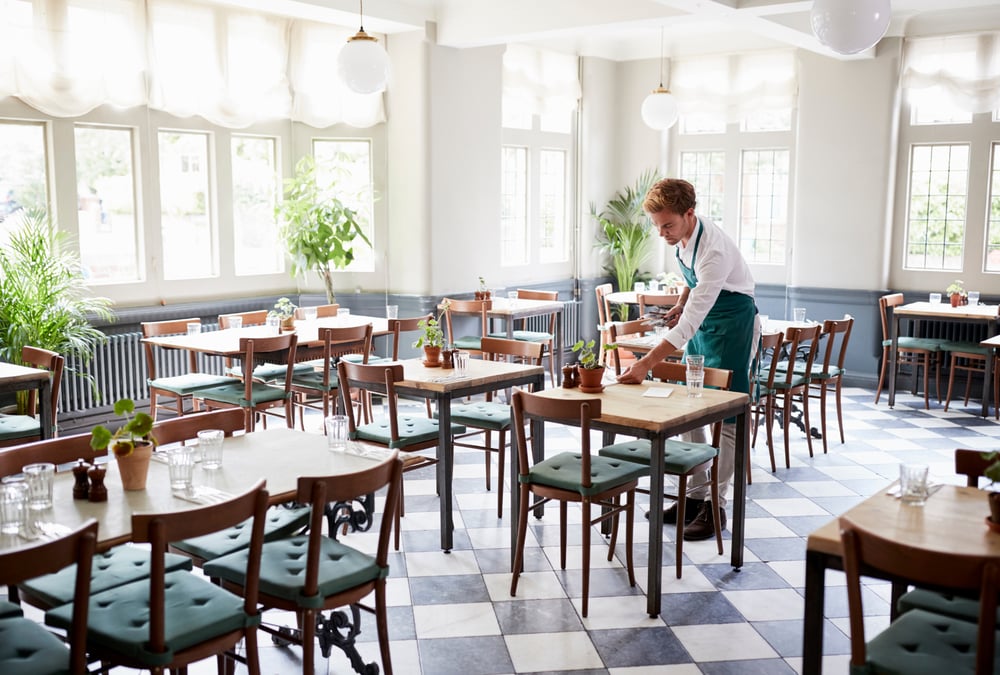A restaurant earns its reputation from two things, food, and service.
When restaurant teams lack motivation, customers will take notice. A demotivated employee will result in slow customer service and a lack of engagement in their work, bringing the entire restaurant team down.
Without your team, your restaurant couldn’t run. So why do your people fall to the back of the pile when things get busy? Restaurant owners desperately want to retain their staff, but how many can say they’re genuinely working on staff retention?
Read on to understand the challenges your restaurant teams are facing, and which strategies you can implement to better motivate and engage your workers.
Quick navigation:
- Why is employee retention a problem in the hospitality industry?
- Common reasons for high turnover in restaurants
- What drives human motivation?
- Nine ways to motivate restaurant employees
Why is employee retention a problem in the hospitality industry?
Retention in the hospitality industry is struggling. The annual employee turnover rate in this industry sits at a staggering 155%, while the average employee tenure is only 2.3 years for hospitality workers in the US.
Just the price alone of finding the right person can be hefty: advertizing the role, time spent reviewing applications, time spent setting up and conducting interviews, and any pre-employment assessments. According to The Centre for Hospitality Research at Cornell University, this average cost of replacing an employee could set you back around $5,864.
Because employees come and go so quickly, it’s only natural that restaurant owners will hire as soon as possible to fill that role, but this is part of the problem. Hiring someone who doesn’t share your team’s values or fit into the culture will only be there for the paycheck at the end of each week/month.
We are also living through The Great Resignation, meaning it’s becoming more challenging to hire new staff. This alone makes it worth taking measures to keep your people around for longer.
Common reasons for high turnover in the the restaurant industry
Lack of flexibility
In the US, 96% of employees said they need flexibility, yet only 47% reported having access to the type of flexibility they need.
Employees in the hospitality industry rarely work a set schedule, which can be a huge benefit to some. But when employees don’t know what shifts to expect each week, it can become stressful. No one wants to wait until the very last minute to get their schedule or find it has changed the day before a shift.
Lack of recognition
Any position within a restaurant team can be demanding. It’s a consuming job with long and unsociable hours, irregular schedules, and heaps of potential stress. It’s not uncommon for restaurant workers to go unrecognized and feel underappreciated by upper management.
Imagine you were in the position where you worked hard, everything went smoothly shift after shift, and there were no complaints, but you didn’t get any recognition for it - not even a simple “well done” or “keep up the good work.”
Recognition shouldn’t just be a top-down exercise. 41% of companies that use peer-to-peer recognition have seen a positive increase in customer satisfaction. When organizations invest in building a strong culture of recognition, employee satisfaction will rise. People will be motivated, happy and energized, they will also be more productive and proactive.
It can be easy to take people for granted and focus your attention on those underperforming.
Toxic work environments
A toxic work environment will cause good employees to leave, leaving only those willing to put up with (or potentially those contributing to) the toxicity. High-pressure working conditions can leave even the calmest and most collected employees feeling stressed out.
Not everyone is suited to this environment, so people look for new opportunities.
Sexual harassment, bullying, and unwarranted favoritism can also wreak havoc, and sadly more than 70% of female restaurant workers have been sexually harassed.
If team communication breaks down and employee conflicts rise, this will create a toxic work environment. Healthy working environments don’t happen by accident. They require ongoing proactive efforts from leadership.
Minimal growth opportunities
Young people want to thrive within the hospitality industry. However, many choose not to stay throughout their careers due to the actual or perceived lack of opportunities for career development.
Unfortunately, part-time and seasonal employees are treated as an afterthought. Many restaurants will provide minimal training opportunities, little skill development, and no clear avenue for those employees who want to grow. According to LinkedIn’s 2018 Workplace Learning Report, 94% of employees said they would stay longer at a company if it invested in their career.
When we feel undervalued, we won’t stick around. If employees don’t feel their employer is invested in them, they won’t invest in the employer.
What drives human motivation?
Now that we have identified what’s going wrong, let’s make it right.
Every good restauranteur knows the most valuable asset isn’t the new equipment you just purchased. It’s the team around you. And an essential part of creating and keeping a great restaurant team is knowing what motivates them to do their best work.
McClelland’s Human Motivation Theory states that there are three driving factors for human motivation: achievement, affiliation, and power. Every employee will be driven by at least one of these and possibly a combination of the three:
- Achievement: Accomplishing goals, taking calculated risks, receiving constructive feedback, and for the most part working alone to help achieve these goals.
- Affiliation: Working with others, feeling liked and valued, having a preference for working collaboratively, and disliking taking risks.
- Power: Desire to have control and the ability to influence others, win arguments, compete and achieve the desired status.
As a restaurant manager, the goal isn’t just to manage your team, but to understand where each member falls on this scale.
Research shows motivated and engaged team members perform 20% better and are 87% less likely to leave a company. While money and benefits are important, they aren’t the only motivating factors.

Nine ways to motivate restaurant employees
1. Flexibility
Flexibility is one of the contributing factors to employee churn in restaurants, so change it. Respect that there is more to life than work and also respect that your team has other obligations outside of the restaurant’s walls.
If someone in your team is under pressure with college work or something significant has happened in their personal life, encourage a harmonious work-life balance where possible. Try to accommodate any time off requests when they’re made well in advance. If a team member calls in sick, don’t leave yourself short - try to have enough staff to cover that illness.
2. Employee engagement surveys
Send out engagement surveys to all staff before you dive right into advancing morale, motivation, and engagement in the workplace.
Often, there will be a disconnect between how a manager perceives a workforce and what actually goes on. Regularly conducting these surveys will give you insight into what motivates your employees.
You could even use employee engagement software (like Mo!) to build high-performing habits to help create a culture of constant improvement from management.
3. Team-building opportunities
No one wants to work with a stranger. When teams trust each other, they tend to perform better, and that’s why employees need to have familiarity with each other.
Shifts can be stressful, making it difficult for employees to form relationships. Going above and beyond by organizing different team-building activities allows employees to break the ice in a less formal and more enjoyable setting. Employees will learn to communicate better and enjoy each others’ company more.
4. Open door policy
You must remember that you’re serving as an example to your team.
Let your walls down and ask employees to provide feedback on where you can improve your skills and what you do well. Make a point of working on your performance to lead by example. Positive attitudes in the workplace are infectious, and if your employees see you trying to better yourself, they will do the same.
It’s also important to have an open door policy where you let employees know if they need anything to talk to you.
5. Communicate goals and values
Employees have to know what they’re working for and working towards. If they don’t, then what’s the point?
As humans, we like to have a purpose. For your team, this might come in the form of trying to better the restaurant’s reputation with excellent customer service or going out of their way to make a customer’s day.
This motivation comes from having a clear goal, vision, and values for the restaurant and effectively communicating them with your team.
6. Keep your tools up-to-date
If you want to motivate and engage your team, then you can’t use technology that makes it difficult to do their job.
Dated POS and reservation software is a recipe for burnout and disaster. Your technology needs to be intuitive and user-friendly to help your team work faster and with fewer mistakes.
7. Incentives and perks
Incentivizing your staff motivates them.
Picture this, let’s say you have a special on the menu that isn’t getting great uptake from your customers. Tell your team that the first person to sell the special to 5 customers will receive a small reward. It could be cash, a complimentary meal, or maybe even a store gift card.
Small incentives can help keep your staff motivated and reduce employee churn. If employees know they will be rewarded for good performance, they’re more likely to put in the effort.
8. Recognition
A lack of recognition can lead to low morale and feeling unappreciated. Whether you go down the incentives and perks route or simply show appreciation for your team by saying thank you for the hard work, recognition helps employees feel a greater sense of belonging and connection to the restaurant and with their coworkers!
Rewards and recognition software can be an excellent solution for your business. Encourage social recognition, seize the moment with spontaneous rewards and create a recognition-rich culture.
9. Ongoing career development and training
Invest in training, education, and career development for all your employees. Restaurant teams want to know they can improve their skills on the job.
Many companies, not just restaurants, will waste their time on training that is repetitive and not engaging. However, online training can help alleviate this by providing a more concise way of delivering information.
Lots of restaurants also tend to only train workers on their first day, with no standardization. Often, new employees are dropped right into the deep end with no access to this information again. This then prevents them from being able to reach their full potential, resulting in demotivated employees that seek better opportunities elsewhere.
When you use formalized training and ensure that workers always have access to it (like they would in eduMe), you combat the problem.
Providing access to ongoing upskilling opportunities also demonstrates to your workers that you are invested in their success and helps them to visualize a long-term future at your restaurant, motivating them to keep improving and performing at their best.
Mo is an employee engagement platform that helps leaders improve collaboration and morale, reduce employee churn and drive change. Mo’s platform creates a recognition-rich culture by developing team habits, encouraging people to celebrate successes, recognize results and appreciate colleagues.








